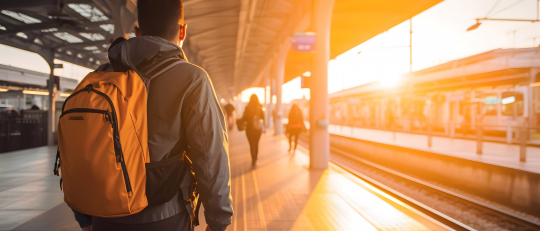
5 universities, 19 colleges of higher education, 16 arts schools, a variety of excellent courses, a central location and a warm welcome: education in the Wallonia-Brussels Federation has more than one trump card up its sleeve to attract foreign students. Still not sure? Charlotte Delmay, in charge of promotional activities for higher education establishments (WB Campus), tells us here about the 6 good reasons to take the plunge.

Charlotte Delmay (WB Campus)
1) To live at the heart of Europe and travel easily

"Living in Brussels or its neighbour in Wallonia also means choosing the capital of Europe and the proximity of European and international institutions. It's also a great place to find internships or start an international career.
"Students under the age of 26 also benefit from very advantageous discounts on public transport tickets, so they can travel easily by train in Belgium or elsewhere in Europe".
2) To benefit from internationally recognised teaching excellence

" 3 of our universities are listed in the top 100 most innovative European universities. Our range of courses is particularly aimed at2nd and3rd cycles (masters, doctorates and post-doctorates). Our institutions have been awarded 4 Nobel Prizes for Medicine, 5 Nobel Peace Prizes, 1 Nobel Prize for Literature, 1 Nobel Prize for Chemistry and 1 Nobel Prize for Physics!"
"A very recent study by the QS World University Ranking institute distinguishes the quality of the university curricula of 4 Belgian universities at world level: UCLouvain manages to place its 'Theology and Religious Studies' programme in 19ᵉ position in the academic discipline, as well as its 'Philosophy' programme (40ᵉ) and the 'Politics and International Studies' programme of the Université Libre de Bruxelles ranks, for its part, in 45ᵉ position among the best curricula in the world in this subject".
"Belgium is one of the most globalised countries in the world, moving here also means meeting students and professors from all over the world. We are also in the top 10 of countries that win the most calls for European projects.
"There are also many joint programmes between French-speaking universities and between French-speaking and Dutch-speaking universities.
3) To save on tuition fees and benefit from attractive grants

"Registration fees are very low compared with most other European countries, and as they are set by decree, they are uniform for all courses. You need to pay €835 a year to enrol at university if you are a student from another European Union country, and €2,505 for non-Europeans (since Europe does not contribute to funding in this case)".
"Several types of scholarships are available, including Master In (WBI) and excellence scholarships".
Find out more about all the scholarships on offer here
4) To be pampered

"There can be no doubt, a stand-out feature of the Wallonia-Brussels Federation is its diversity and openness to the world."
"The campuses of the Wallonia-Brussels Federation have put in place a large number of initiatives to welcome their foreign students. Kots à projets, welcome days, international weeks, sponsorship systems: everything is put in place to provide a warm welcome to students from the four corners of the world".
5) To learn French

"French is the 5th most spoken language in the world, the2nd most taught and the3rd most used in the business world. So it's a great asset on the job market and more differentiating than English on a Curriculum Vitae".
"French courses are also offered free of charge on campus and can be taken regardless of the language chosen (French, English or bilingual course). In some cases, these courses can even be integrated into the curriculum and count as credits".
6) To party and enjoy a rich cultural life

"We're lucky to be able to enjoy an incomparable quality of life. Lots of green spaces and nature, a large network of cycle paths thanks to the Ravel, but also a very rich and varied cultural programme. Music festivals in particular attract young people from all over the world.
"The student card also gives you great discounts on cultural and sporting activities.
"We can also remind you that you can eat well in Belgium, even if it's not beer, chips and chocolate!
Further information and registration